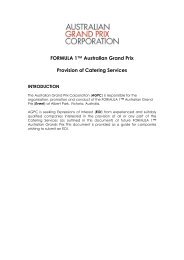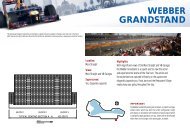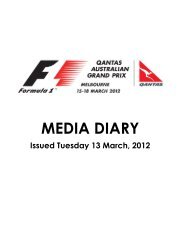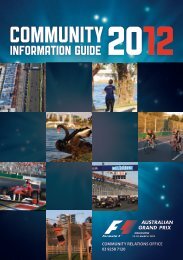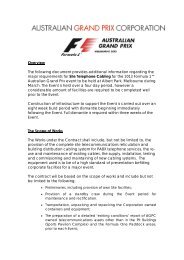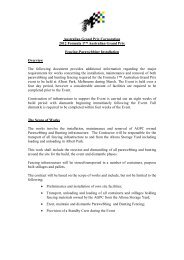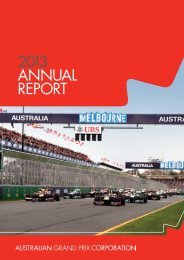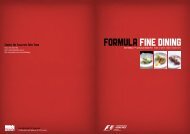Annual Report 2011 Australian Grand Prix Corporation
Annual Report 2011 Australian Grand Prix Corporation
Annual Report 2011 Australian Grand Prix Corporation
Create successful ePaper yourself
Turn your PDF publications into a flip-book with our unique Google optimized e-Paper software.
Notes to and Forming Part of the Financial Statementsfor the Financial Year Ended 30 June <strong>2011</strong>part of a group of financial assets that are managed by the <strong>Corporation</strong> based on their fair values,and have their performance evaluated in accordance with documented risk management andinvestment strategies.Financial instruments at fair value through profit or loss are initially measured at fair value andattributable transaction costs are expensed as incurred. Subsequently, any changes in fair valueare recognised in the net result as ‘other economic flows’. Any dividend or interest on a financialasset is recognised in the net result from transactions.Financial liabilities at amortised costFinancial instrument liabilities are initially recognised on the date they are originated. They areinitially measured at fair value plus any directly attributable transaction costs. Subsequent toinitial recognition, these financial instruments are measured at amortised cost with any differencebetween the initial recognised amount and the redemption value being recognised in the profitand loss over the period of the interest bearing liability, using the effective interest rate method.Financial instrument liabilities measured at amortised cost include all payables, deposits held andadvances received, and interest-bearing arrangements other than those designated at fair valuethrough profit or loss.Offsetting financial instrumentsFinancial instrument assets and liabilities are offset and the net amount presented in the balancesheet when, and only when, the <strong>Corporation</strong> has the legal right to offset the amounts and intendeither to settle on a net basis or to realise the asset and settle the liability simultaneously.Reclassification of financial instrumentsSubsequent to initial recognition and under rare circumstances, non-derivative financial instrumentsassets that have not been designated at fair value through profit or loss upon recognition, may bereclassified out of the fair value through profit or loss category, if they are no longer held for thepurpose of selling or repurchasing in the near future.Financial instrument assets that meet the definition of loans and receivables may be reclassified outof the fair value through profit and loss category into the loans and receivables category, wherethey would have met the definition of loans and receivables had they not been required to beclassified as fair value through profit and loss. In these cases, the financial instrument assets may bereclassified out of the fair value through profit category, if there is the intention and ability to holdthem for the foreseeable future or until maturity.Derivative financial instrumentsDerivative financial instruments, being foreign exchange forward contracts and foreign exchangeoptions, are held to hedge the <strong>Corporation</strong>’s foreign currency exposures. The <strong>Corporation</strong> applieshedge accounting where applicable.On the initial designation of a hedge, the <strong>Corporation</strong> formally documents the relationship betweenthe hedging instrument(s) and the hedged item(s), including risk management objectives andstrategy in undertaking the hedge transaction, together with methods that will be used to assess36<strong>Australian</strong> <strong>Grand</strong> <strong>Prix</strong> <strong>Corporation</strong> <strong>Annual</strong> <strong>Report</strong> <strong>2011</strong>



